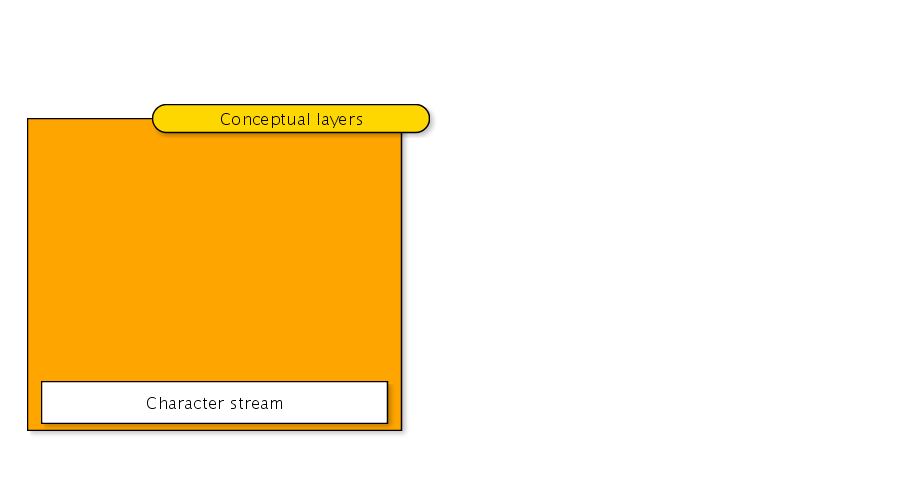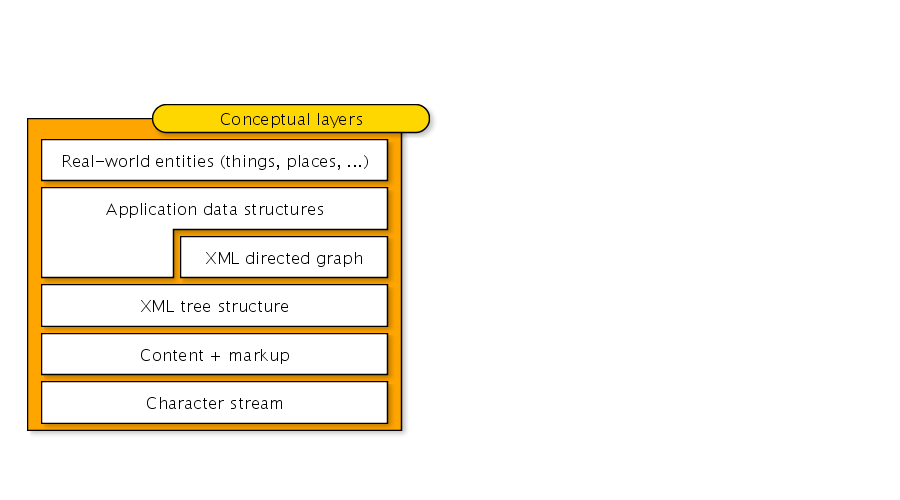What does XML have to do with Immanuel Kant?
C. M. Sperberg-McQueen
Net.ObjectDays 2004
5. Internationale GI-Fachtagung für Objektorientierte und Internet-basierte Technologien, Konzepte und Anwendungen.
Erfurt
29. September 2004
- 1. What makes the Web special?
- 2. What makes the Web special?
- 3. What makes the Web special?
- 4. What makes the Web special?
- 5. What makes the Web special?
- 6. What makes the Web special?
- 7. What makes the Web special?
- 8. What makes the Web special?
- 9. What makes the Web special?
- 10. What makes the Web special?
- 11. A cautionary note
- 12. The World Wide Web Consortium
- 13. Some consequences
- 14. W3C organization
- 15. We need your help
- 16. What makes XML special?
- 17. What makes XML special?
- 18. XML
- 19. XML is a language
- 20. XML is a metalanguage
- 21. DTDs do two different things
- 22. Four layers, four or more specs
- 23. What we foresaw (and a bit more)
- 24. Conceptual layers
- 25. Conceptual layers
- 26. Conceptual layers
- 27. Conceptual layers
- 28. Conceptual layers
- 29. Conceptual layers
- 30. Conceptual layers
- 31. Conceptual layers
- 32. Conceptual layers
- 33. Conceptual layers
- 34. Conceptual layers
- 35. Implications of the stack
- 36. World domination through markup
- 37. What will data processing be?
- 38. Further implications
- 39. Yet further implications
- 40. What makes XML special?
- 41. What makes XML special?
- 42. Answer to the question “What is enlightenment?”
- 43. Thank you
What makes the Web special? |
Why the World Wide Web, and not (e.g.) Guide or InterMedia or System-G?
What makes the Web special? |
Why the World Wide Web, and not (e.g.) Guide or InterMedia or System-G?
- first off the block?
What makes the Web special? |
Why the World Wide Web, and not (e.g.) Guide or InterMedia or System-G?
first off the block
What makes the Web special? |
Why the World Wide Web, and not (e.g.) Guide or InterMedia or System-G?
first off the block- improved reliability?
What makes the Web special? |
Why the World Wide Web, and not (e.g.) Guide or InterMedia or System-G?
first off the blockimproved reliability
What makes the Web special? |
Why the World Wide Web, and not (e.g.) Guide or InterMedia or System-G?
first off the blockimproved reliability- innovation?
What makes the Web special? |
Why the World Wide Web, and not (e.g.) Guide or InterMedia or System-G?
first off the blockimproved reliabilityinnovation
What makes the Web special? |
Why the World Wide Web, and not (e.g.) Guide or InterMedia or System-G?
first off the blockimproved reliabilityinnovation- simplicity?
What makes the Web special? |
Why the World Wide Web, and not (e.g.) Guide or InterMedia or System-G?
first off the blockimproved reliabilityinnovation- simplicity
Why was it made simple?
What makes the Web special? |
Why the World Wide Web, and not (e.g.) Guide or InterMedia or System-G?
first off the blockimproved reliabilityinnovation- simplicity
Why was it made simple? In order to scale.
A cautionary note |
Simplicity is not enough.
Consider the story of Gopher. And remember Albert Einstein.
The World Wide Web Consortium |
Our mission: to lead the Web to its full potential.
Our goals:
- universal access
- semantic Web
- trust
- interoperability
- evolvability (through simplicity, modularity, compatibility, extensibility)
- decentralization
- cooler multimedia
Some consequences |
Because of our goals, we care about
- scalability
- decentralization
- consensus-based standardization
- vendor neutrality
- openness (both technical and social)
- freedom to implement W3C specifications
- clarity concerning intellectual property rights
W3C organization |
A decentralized world-wide organization.
- members from Europe, North America, and Asia
- Working Groups, Advisory Committee
- technical staff
- host organizations
- ERCIM (European Research Consortium for Informatics and Mathematics), Sophia-Antipolis
- Keio University, Tokyo
- Massachusetts Institute of Technology, Cambridge, Mass.
- offices in many regions: Australia, Benelux, Finland,
Germany/Austria, Greece, Hong Kong, Hungary, Israel, Italy,
Korea, Morocco, Spain, Sweden, United Kingdom and Ireland.
- outreach, publicity, workshops, etc.
- translations (e.g. the books XML & Co and XHTML, CSS & Co, http://www.edition-w3c.de/#Buecher)
We need your help |
As customers, demand that your vendors support open standards!
As users, read and comment on our draft specifications!
As developers, read and comment on our draft specifications,
and then implement them!
As institutions, join the W3C to give users and developers
a stronger voice
within the organization!
What makes XML special? |
First, the heritage of SGML (Standard Generalized Markup
Language, ISO 8879):
- generic / generalized / descriptive markup (vs. application-specific)
- for data reuse
- for data longevity
- (therefore) declarative markup (vs. imperative)
- information has validatable structure
- markup semantics are defined by application, not centrally
- (ideally) markup semantics fit the application
XML |
Some dates:
Has XML lost its simplicity?
1967: early work on generic markup: logical markup,
not appearance- or process-oriented
1973: Generalized Markup Language
1986: Standard Generalized Markup Language (SGML) an ISO standard
1996: Work on ‘SGML on the Web’ starts in W3C
- Make SGML Web-ready. Keep XML SGML-compatible.
- Keep the power: nested structure, world view, reusability, generic markup, data ownership.
- Lose the cruft: simplify, simplify!
1998: XML 1.0 becomes a W3C Recommendation
2004: over 20 XML-related specs at W3C — why so many?
XML is a language |
The syntax of XML is simple:
<doc>
<rule number="1">Everything is delimited.
<elucidation>
<subrule>Elements are delimited by <term>start-</term>
and <term>end-tags</term>.</subrule>
<subrule>Tags are delimited by angle brackets.</subrule>
<subrule>Attribute values are delimited by
quotation marks.</subrule>
</elucidation>
</rule>
<rule number="2">Everything nests.
<elucidation>
<subrule>Elements occur within elements.</subrule>
<subrule>Attributes are specified within start-tags.</subrule>
</elucidation>
</rule>
</doc>
What we foresaw (and a bit more) |
The original plan:
- XML (a lightweight SGML) 1998
- generic markup
- validation
- XLink / XPointer (lightweight HyTime) 2002, 2003
- stand-off links
- n-way linking
- structure-based addressing
- XSL (lightweight DSSSL) 1999, 2001
- structure-based formatting and rendering
- tree transformations
- flow objects
- XML applications / XML-based languages (SMIL, XHTML, MathML, ...)
An early addition: XML Namespaces 1.0.
Implications of the stack |
XML Information Set: what is information, what is
insignificant variation
XML 1.1: alignment with Unicode 3
XML Namespaces 1.1: improve processing on abstract model, re-serialization
What will data processing be? |
 When you have a good hammer ...(Possible analogies with Jenny, die Seeräuberbraut, or with Joh. Faustus.)
When you have a good hammer ...(Possible analogies with Jenny, die Seeräuberbraut, or with Joh. Faustus.)
Further implications |
If XML is a good way to represent complex data, then we'll also need:
- APIs for XML
- Document Object Model (DOM)
- Simple API for XML (SAX)
- XML querying
- XPath
- XQuery
- XSLT
- XML-to-XML transformations
- XQuery
- XSLT
- XML messages for distributed applications
- SOAP
- Web Services description, choreography
- Digital signatures, encryption
- ontologies for distributed processes, services, clients, ...
- XML applications (commercial, academic, ...)
Yet further implications |
And what about
- semantics
Every XML vocabulary entails (implicitly or explicitly) an ontology.
Can we connect them to each other?
What makes XML special? |
- ownership of information
- freedom from vendor lock-in
- freedom from pre-defined semantics
- application independence
What makes XML special? |
- ownership of information
- freedom from vendor lock-in
- freedom from pre-defined semantics
- application independence
- responsibility for information
- You must think about the processing you need.
- You must decide what information you wish to capture, and what information you wish to discard.
Answer to the question “What is enlightenment?” |
Aufklärung ist der Ausgang des Menschen aus seiner selbst verschuldeten Unmündigkeit. Unmündigkeit ist das Unvermögen, sich seines Verstandes ohne Leitung eines anderen zu bedienen.
-Kant
Enlightenment is the emancipation of the individual from a self-imposed tutelage. Tutelage is the inability to use one's reason without direction from another.
Thank you |
C. M. Sperberg-McQueen
Member, Technical staff
World Wide Web Consortium
cmsmcq@w3.org
Member, Technical staff
World Wide Web Consortium
cmsmcq@w3.org
For more information: http://www.w3.org/XML














